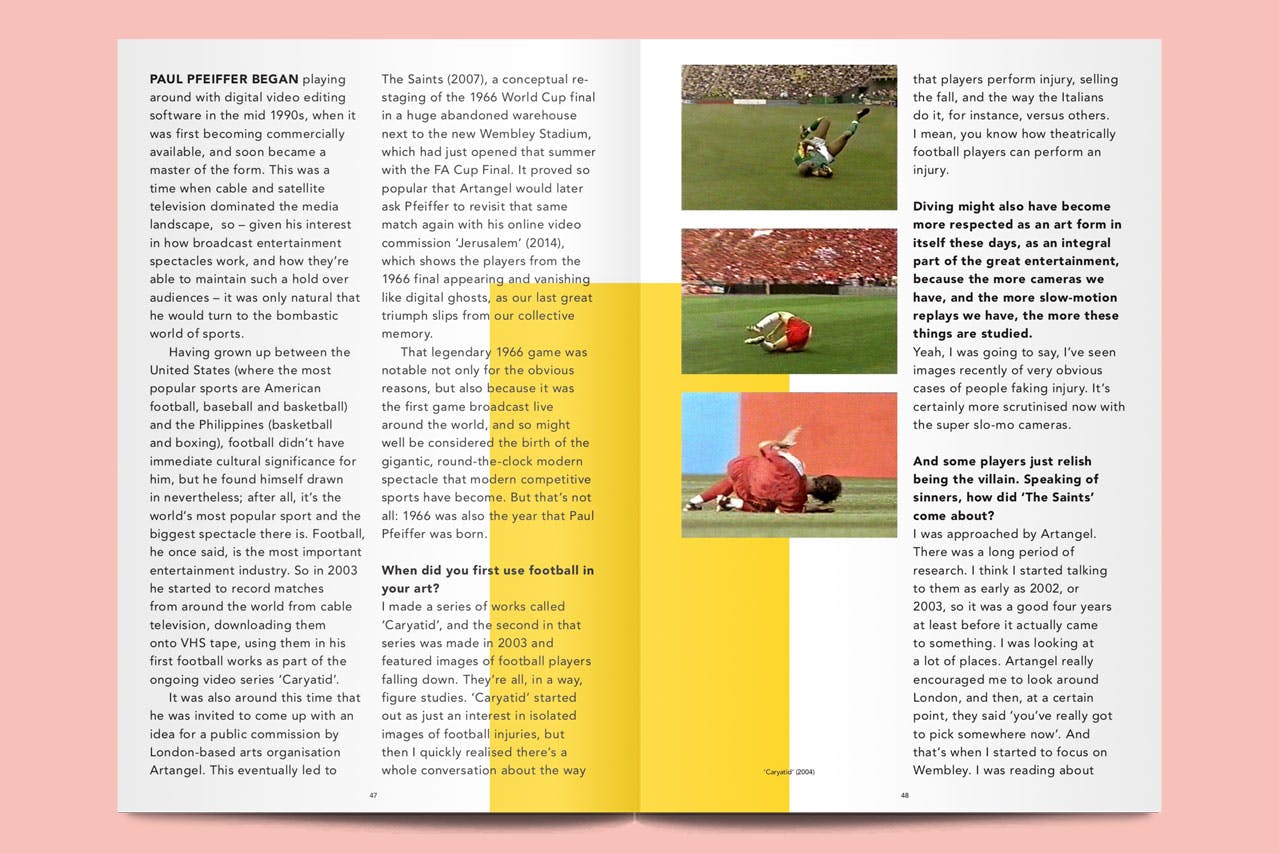David Beckham, naked

Oof combines art and football for emotional reasons. Because, editor Eddy Frankel explains, “football does with ease what art constantly tries to do: it makes people feel”. The need to feel something, with its underlying fear of not being able to feel anything at all, is a curious starting point for a magazine. The cover-star elicits emotion of a hysterical kind. It’s David Beckham, pictured naked and sleeping, so close-up you can almost smell him. The theme for this edition, Oof’s third, is obsession: the pleasure and the pain of feeling too much.
All the pieces in the issue deal with the complexity of devotion. Eddy himself travels to Ukraine to interview hooligans who organised a truce in the middle of a revolution to save a statue of a football coach. There’s a hopefulness to that story of fanatical love. But the violence implicit in loving — the way we trash, as well as treasure our idols — is keenly felt throughout the magazine. Particularly in the opening feature, which explores the demonisation of black footballers in the press, via analysis of the artist Ashley Holmes’ football sticker-inspired ‘Panini Series’.
The insight that stays with you, though, is of obsession as a void. Ossian Ward describes Beckham not as a person, but as a great nothingness: “a symbol of a symbol… an extraordinarily complex construction of character, personality and desire.” The nice thing about Oof is you don’t have to like football, or art, to like it. It’s a magazine about feeling: the way we create, and swallow up, and are swallowed up by, the things we love.
We asked Eddy to pen us a five-point guide to the sparkly new issue.
1. Obsession
My whole thing with how I approach the content of Oof, is that I’m not interested in art that’s about football. A painting of a famous player, or of a historic moment in football history: I don’t care about that shit. What I care about is the way artists use football to say something about society. And most of the art in this third issue deals, in some way, with the concept of obsession. We deify the footballers that you can see blown up to giant size in Ashley Holmes’ collectible sticker-based ‘Panini Series’, we idolise and objectify players like David Beckham as in Sam Taylor-Johnson’s serene sleeping portrait. Or maybe we let the obsession REALLY take hold, like the Swiss artist Massimo Furlan, who recreates whole games from history, but by himself, without a ball, for a full 90 minutes. Every one of these works offers an insight into the human capacity to obsess, to devote, to love something beyond reason.
2. Racism
Ashley Holmes is a young black English artist. Like lots of people around the world, he grew up collecting football stickers. The black players in the collection were among the most prominent people in society, living gods, athletic objects of worship. But those same players are the victims of press attention that white players never get — Raheem Sterling, for example, is dragged through the tabloid mire, week after week, mocked and denigrated for… what, buying his mum a house? Getting a tattoo? Holmes exposes the hypocrisy of it all, and in the process exposes the rampant racism that exists in both football and the wider world.
3. Movement
Back in the ’90s, Barcelona played away to Hertha Berlin. A thick blanket of fog descended on the game, and by halftime players couldn’t see from one end to the other. Journalists couldn’t even report on the match, so thick was the mist. The brilliant Belgian-British artist Ann Veronica Janssens took the footage from that match (which she initially watched in a bar) and edited it into a silent meditation on movements that become increasingly isolated as time goes by.
4. Violence
During the Euromaidan revolution in Ukraine, the central streets of the capital — Kiev — were ruined by riots, bloodshed and fighting. Somehow, in among all that destruction and death, a group of people decided to save a single statue. The work depicts Valeriy Lobanovskyi, the most important football coach in Ukrainian history. I went out to Kiev in the middle of December, for some fucking reason, to find out how one man could mean so much. I met some hooligans, I drank some vodka, and I got really cold. You have to suffer for your magazine.
5. History
We close every issue of Oof with a look at a football-focused work from art history. In this issue, we chose Umberto Boccioni’s ‘Dynamism of a Football Player’. Boccioni was one of the main Italian Futurists in the inter-war period, and used his vivid brushwork to create semi-abstract works that screamed modernity and a vision for the future. In the movement of a football player, he saw a whole story of group dynamics, of individuals as part of a whole. Also, it’s really pretty.












